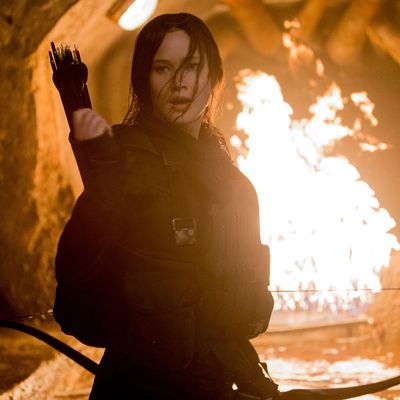
When people talk about the success of the Hunger Games films, director Francis Lawrence rarely gets enough credit. He’s the helmer of the last three movies of the series — Catching Fire and Mockingjay Parts 1 & 2 — and in each of them, just as with such past projects as Constantine, I Am Legend, and NBC’s little-watched Kings, Lawrence exhibits a level of craft and attention to detail that fans of big-budget studio pictures don’t often see. Now that his time with the Hunger Games franchise has drawn to a close, Vulture talked to Lawrence about six of the bigger creative challenges he faced while filming those three movies — everything from nailing the tone of crucial scenes to visualizing complex stuntwork.
The Fog Attack (Catching Fire)
“The fog sequence was especially tricky because it was filmed with IMAX cameras. So even though that whole section of the arena was IMAX aspect ratio for 25 to 30 minutes, the rest was without. That posed some extra complexities, as you’re covering a lot more ground — whereas in the mandrill scene, for example, you’re basically in one spot. The fog sequence involved multiple locations and people racing through the forest. We had to figure out the timing and the geography of the fog itself: the speed of the fog, where the fog is coming from, how it catches up with them, and the timing of the scene where Mags stops and sacrifices herself by walking into the fog. We had to allow [actress Lyn Cohen] enough time to show Mags’s emotions while keeping the tension of the encroaching fog. That was difficult.”
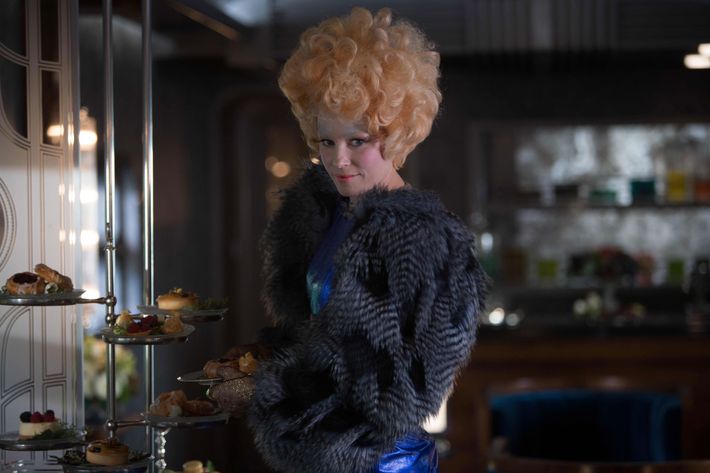
Filming the Capital Citizens (Catching Fire)
“An early element of the Hunger Games series is the campiness of the Capital, but the overall story moves progressively into pretty bleak territory. I originally signed on for Catching Fire, and it was only when we were partway through preproduction that I was invited to stay for the rest of the movies. I then started to look forward to the tone of the final book, and at what those two movies would become. I realized that Catching Fire is really where the tone is starting to shift. So I had to start the work there. I obviously didn’t want to get rid of all of the levity. You want to keep some of that fun and flamboyance since that’s what separates the citizens of the Capital from the different districts. But I definitely wanted to tone some of that energy down a little bit so we could ramp into the Mockingjay movies, which are so tonally different.
I think the biggest differences can be seen with Caesar Flickerman and with Effie Trinket. In the first film, they’re more like hosts. But in the second film, when Katniss goes out on that stage, and when the other tributes start to manipulate the show, Flickerman’s feeling different things. It’s a layered performance, now driven by a guy who’s getting nervous as opposed to a guy who’s just putting on a show. The same thing with Effie: She’s a certain kind of character in the first movie, and then in the second she’s going through the districts, and all the kids she’s meeting end up dead. There are two kids she actually starts to love. So there’s much more human emotion there that’s coming up because there are so many other things happening to her as a character.
Because the Capital sequence is so big, there wasn’t much of a rehearsal process. Everybody’s working so sporadically, but there were times when I got to sit down with an actor, talk about what their character is going through, talk about the scene. I was really just talking about things on an emotional level: what it feels like for Effie, how proud she would be in the beginning, how torn she would be at the Quarter Quell, and how a Capital citizen who normally appears cold and unfeeling could seem conflicted about her ties to the Capital.”
The Attack on the Dam (Mockingjay Part 1)
“That scene was just mentioned in the book, so for some of Part 1 — and really, for all three of our films — we had to do what’s called ‘world expansion.’ In this case, it was screenwriter Peter Craig’s idea to show the dam scene. It took a while to expand the idea, but in time we thought of this mass horde of rebels storming the Capital, approaching the dam, ready to sacrifice themselves. They have to get past the Peacekeepers, who are firing automatic weapons. That was shot in numerous locations, and it was something that was precisely story-boarded and pre-visualized. We had to build certain parts of the dam. We shot the quarry down in Atlanta. There was a huge amount of digital work done by a company called [ScanlineVFX] that does very large-scale projects, and water work. It’s actually one of my favorite scenes in Mockingjay Part 1. I really liked the idea of Katniss singing this really haunting Appalachian folk song, and this footage being chopped up, or slightly changed by Plutarch, and then being broadcast out. That kind of leads to these District rebels singing that same song as they march to their own deaths. I found that powerful.”
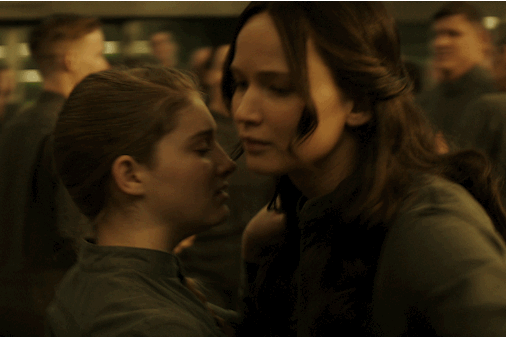
Katniss and Prim’s hug at Finnick’s Wedding (Mockingjay Part 2)
“This is quite different from the book. At this point, Katniss decides to be a rebel and go away from the District to fight the Capital. So when she’s dancing with Prim at the wedding, she realizes that this could be the last time she’s with Prim. I designed a camera move that followed Katniss into the crowd. It felt like we were with them because it starts off static, like we were using a steadicam. Then when Katniss stops dancing, and hugs her, and holds her, they stop, but the camera keeps going, as if they were still dancing. So the camera circles around them, and moves progressively toward their faces. It was a really nice way of isolating them from all the people celebrating around them.”
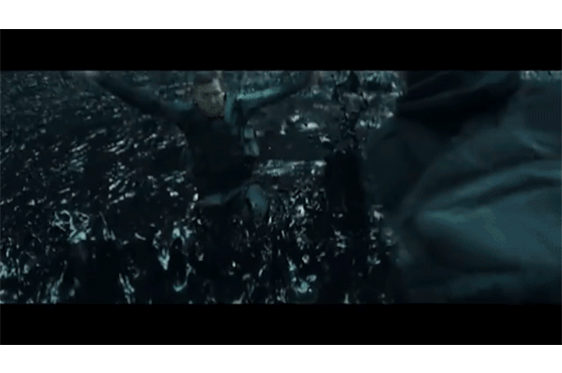
The Oil-Spill Attack (Mockingjay Part 2)
“We knew we had to have this sequence, so we had to figure out how it was going to work. We had to shoot in the Capital, and we were not going to find that in Atlanta, where we were shooting other sequences. So we went through a list of classical and brutalist architecture. We found some buildings in Berlin, and a bunch of great buildings in Paris. We shot partially in a suburb just outside Paris. Once we had scouted it, we knew it would be the perfect spot for the oil. Where we shot was totally enclosed; it almost seemed like a fishbowl. Then we started to plan the sequence based on the location we picked out. All the storyboards were based on the location, as well as the pre-viz and the stunt-viz, which is something I do a lot for action scenes. We start with storyboards, but then we actually have real people act it so we get the choreography right, as well as the camera angles with real people.”
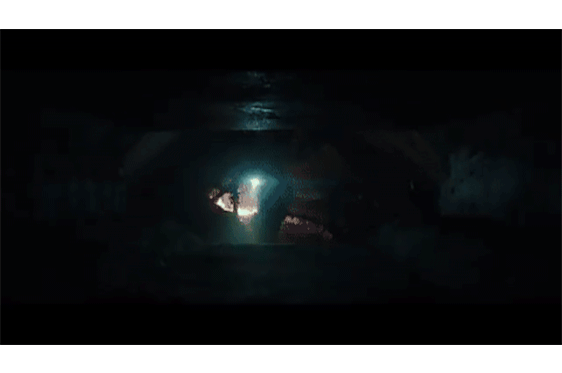
The Tunnel Fight (Mockingjay Part 2)
“For the mutt attack I used some tricks I learned while making I Am Legend. I enjoy those kinds of sequences, the scary scenes. It was very clear from the beginning that there was going to be something there. The tunnels we designed were very claustrophobic, so I was inspired by one sequence from Alien, where Dallas is looking for the creature in the air ducts. That sequences is more claustrophobic than ours. But the ceilings were so low in our tunnels that the tallest member of the squad has to duck to walk through them. Then when the creatures show up, they fill the ducts, and they fill the frame.
So we built these dark, dark, dark tunnels, and gave you the feeling that these creatures are out there. Then I had fun playing with expectations, setting up all these moments where you think they could pop out. The music goes silent, and Katniss crawls through that tight space. You keep playing with people’s expectations, which really adds to the suspense.
Eventually, the creatures pop out, and they fight. This was a really complex scene; it took a lot of creative rounds. We had to make sure it was clear who was with who, when people get separated, how’s it going to feel (is it going to feel chaotic?), the geography of where the creatures are coming from, and what the objective was (to get up the ladder). We storyboarded again, went through pre-viz, and it was still hard to get the right sequence. That’s where we benefited from the stunt team doing their stunt-viz.
We had the design for the tunnel, so the stunt guys built a mock-up of that room, and they got a bunch of people to play our characters as well as the creatures. They took the storyboads from pre-viz as a guide. Our stunt coordinator, Sam Hargrave, choreographed the stunts and the fights for all three films. He spends a couple days filming the temp sets, and the mock-ups, and he brings back the footage. We string it together and talk about it, change it. So by the time we shot, we knew where everything was, the actors knew the choreography, and it was a really well-organized space.”




